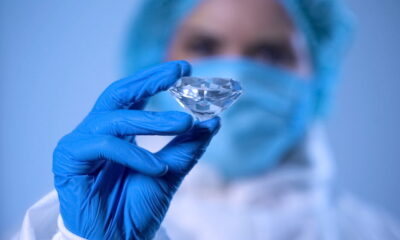Eco-friendly and ethical consumers have a lot of things to think about. We think about the environmental and human impact of products that we buy every day. However, we don’t give as much consideration to things like diamonds, since we purchase them far less regularly.
Diamonds are an example of products that have a huge social and environmental cost that we don’t think as much about. We often want to overlook it, because we are buying them once or twice.
The issues associated with diamonds have only recently begun to gain attention, as more people talk about the problems of conflict diamonds and the environmentally destructive process of mining them even in conflict-free zones. For thousands of years, diamonds have been a symbol of love and wealth when embedded in a piece of fine jewelry, and for good reason. They are beautiful and sparkle like no other stone. Their rarity also adds to the value of the stone, making them even more expensive and sought after. But at what cost does diamond mining come? ‘Blood’ and ‘conflict’ diamonds have a known history of exploiting adult and child workers, funding war in mining countries, and causing irreparable damage to the environment.
‘Conflict’ and ‘Conflict-free’ diamonds
What are ‘conflict’ diamonds? The Kimberley Process Certification Scheme (KPCS) was established in 2003 to stop conflict diamonds from being sold.
Creating the label of ‘conflict’ diamonds has made it possible for jewelers who source ethically mined diamonds to label their stones as ‘conflict-free’. As great as this sounds, there are a few cracks in KPCS’s definition. Humanitarian conflicts and environmental impact are not included in making diamonds ‘conflict-free’. Because of this, diamonds from places like Zimbabwe, which is notorious for human exploitation, are able to be labeled as ‘conflict-free’. Those diamonds are later sold to consumers who think they are buying a sustainable and ethical stone.
Humanitarian Conflicts
The diamond mining industry is notorious for human exploitation. Many diamond workers are underpaid and working in dangerous conditions, with little or no safety equipment or training. Mining companies work with the goal of extracting diamonds at the lowest price possible to maximize profits. Children in these areas are employed and paid at even lower rates to keep costs at a low.
Environmental Effects
In order to keep extraction costs low, irresponsible mining techniques are commonly used. The rerouting of rivers and dam constructions in order to expose mining areas have disastrous consequences on fish and ecosystems. Soil erosion is another major problem with many diamond mining techniques. In fact, one carat of a mined diamond approximately removes 250 tons of earth/soil, requires 120 gallons of water, and emits 140 lbs. of carbon dioxide. Once a mine has been used, the area is left with no assistance in environmental renewal. Thousands of abandoned diamond mines all over the world have left landscapes completely desolate, with no wildlife and extensive topsoil erosion, which makes farming impossible.
Diamond Alternatives
In order to combat ‘conflict’ diamond sales, many sustainable and ethical diamond alternatives have emerged over the years. Lab-grown diamonds are a great alternative. Lab-grown diamonds are identical to mined diamonds and 100% ‘conflict-free’ with no uncertainty about humanitarian or environmental conflicts.

































